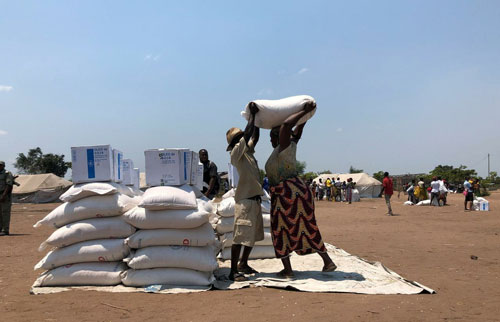Johannesburg
An unprecedented 45 million people in southern Africa are in urgent need of food aid due to drought, flooding and economic hardship, the UN said Thursday.
“This hunger crisis is on a scale we’ve not seen before and the evidence shows it’s going to get worse,” World Food Programme (WFP) regional director Lola Castro said in a statement.
The agency warned that it had only secured $205 million (184 million euros) of the $489 million it requires.
“If we don’t receive the necessary funding, we’ll have no choice but to assist fewer of those most in need, and with less,” Castro said.
Low growth, rising population, drought and floods have combined to worsen food insecurity in the region, with Eswatini, Lesotho, Madagascar, Malawi, Mozambique, Namibia, Zambia and Zimbabwe the worst-hit.
Nearly half of Zimbabwe’s 15 million people live in a state of chronic food insecurity—some 2.2 million in urban areas and five million in the countryside, according to UN figures.
Twenty percent of the population in drought-stricken Lesotho and about 10 percent of Namibians are food insecure.
In October, Zambia’s Red Cross flagged that the drought had left an estimated 2.3 million people facing “severe food insecurity”. The country was a longtime regional breadbasket. The WFP warned that families across the region were already eating less, skipping meals, taking children out of school, selling off precious assets and falling into debt to stave off agricultural losses. Women and children are the worst affected.
Meanwhile, experts have forecast more months of hot and dry weather in the coming months, auguring another poor harvest.
The situation could escalate further as the dry season may last longer than usual, affecting the annual cereal harvest in April.
The WFP plans to provide lean season assistance to 8.3 million people in areas that are grappling with crisis levels of hunger.
Meanwhile, the United Nations said Wednesday that the past decade was the hottest on record, with 2019 confirmed as the second-hottest year in history. The hottest year ever recorded was 2016.
“The average global temperature has risen by about 1.1°C since the pre-industrial era and ocean heat content is at a record level,” Petteri Taalas, Secretary-General of the World Meteorological Organization (WMO), said.
“On the current path of carbon dioxide emissions, we are heading towards a temperature increase of 3 to 5 degrees Celsius by the end of century.”
The WMO’s findings are based on leading data sets from around the world. “The year 2020 has started out where 2019 left off, with high-impact weather and climate-related events,” said Taalas. “Unfortunately, we expect to see much extreme weather throughout 2020 and the coming decades, fueled by record levels of heat-trapping greenhouse gases in the atmosphere.”
Taalas pointed specifically to the bushfires ravaging Australia, which have killed at least 28 people, displaced tens of thousands, and killed up to 1 billion animals.—APP










